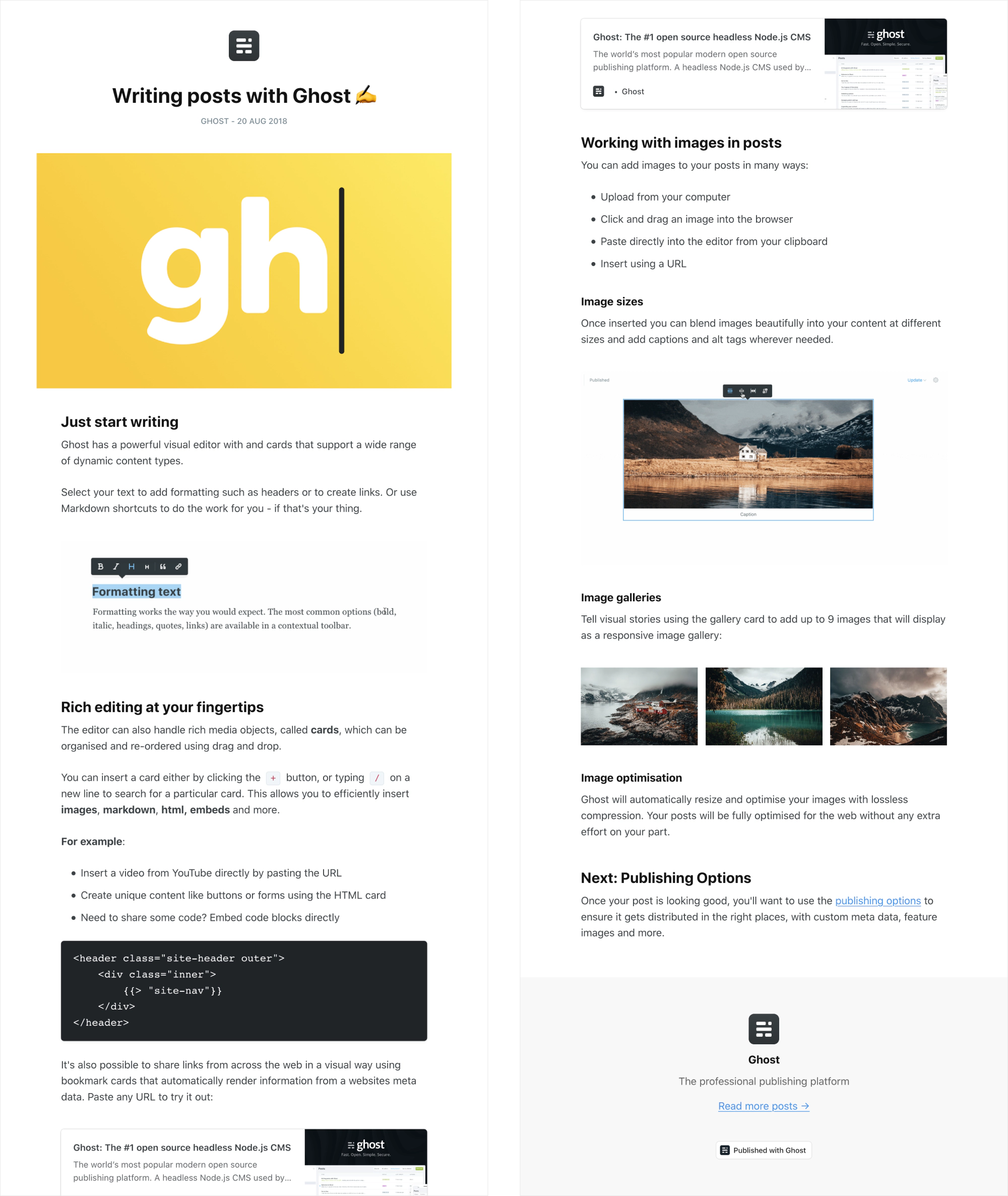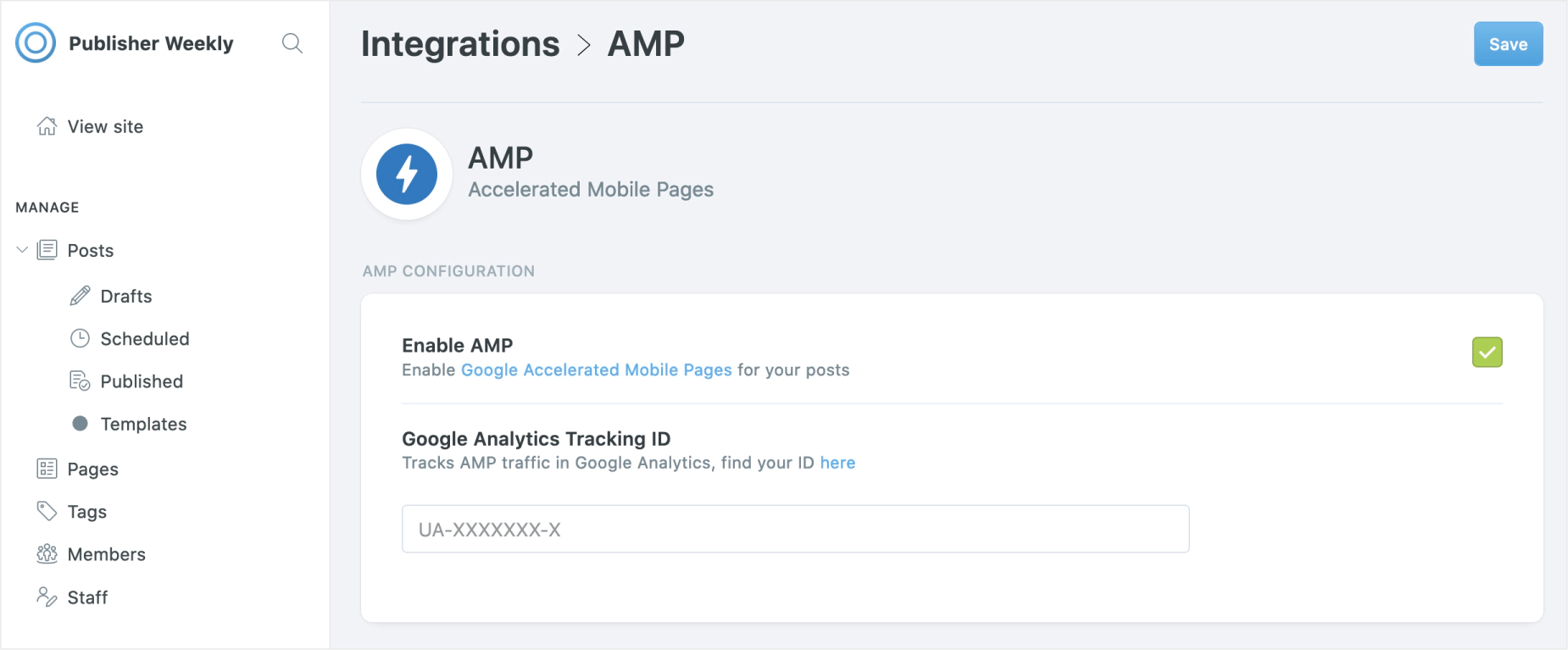Ghost comes with a built-in integration for Google AMP which transforms all of the content on your site into a lightning-fast AMP version ⚡
The open source AMP project is led by Google, and provides a way for publishers to generate lightweight versions of their content for a faster and smoother user experience.
In Ghost, the AMP integration utilises the AMP framework inside a single Handlebars template: amp.hbs. This template transforms each post on your site into an AMP version which can be accessed by adding /amp to the end of any URL.
Ghost has a beautiful default AMP template which displays all of your content, images, galleries, code and bookmark cards for mobile devices.

Enabling AMP in Ghost
The AMP integration in Ghost is enabled by default, but if you prefer not to use the feature then you can turn it off in the settings within Ghost Admin. When enabled, all posts on your publication will automatically have an AMP page, with a canonical link to ensure the page is correctly identified by the search engines and no duplicate content issues are found.
AMP Analytics
If you’d like to track your AMP performance in Google Analytics, you can integrate AMP Analytics in a few simple steps, by entering your Google Analytics Tracking ID in your integrations settings:

Hit save and you’ll have successfully installed AMP Analytics 🎉
Customise the template with your own styles
AMP in Ghost can be styled to suit your brand and theme too! Since the Ghost theme layer is entirely customisable, that means you can also customise the way your AMP pages are rendered by including a custom amp.hbs template file in your theme.
To access any post rendered using the amp.hbs template on your site, add /amp/ to the end of any post URL on your publication. The parent post also has a canonical link to it’s AMP equivalent.
Template
The amp context always uses the amp.hbs template. Ghost will look for this template within your theme files and use this by default.
The template structure is as follows:
.
├── /assets
| └── /css
| ├── screen.css
| ├── /fonts
| ├── /images
| ├── /js
├── default.hbs
├── index.hbs [required]
└── post.hbs [required]
└── amp.hbs [optional]
└── package.json [required]
Check out the default template in full.
Data
The amp context provides access to the post object which matches the route. As with all contexts in Ghost, all of the @blog global data is also available.
When outputting the post, you can use a block expression ({{#post}}{{/post}}) to drop into the post scope and access all of the attributes. See a full list of attributes.
AMP features
AMP consists of three different parts:
- AMP HTML
- AMP JS
- Google AMP Cache
AMP has many restrictions for optimal performance. For example, JavaScript can only be used in certain circumstances, CSS must be in the correct tags inside of the <head> section, and AMP HTML must be used instead of common HTML.
If you are making adjustments to your amp.hbs file, follow the documentation provided on the official AMP docs site.
Edited amp.hbs templates can be updated in your theme by uploading a .zip of your updated theme in Ghost admin.
Debugging AMP
Since AMP has strict restrictions, it’s important to ensure that your code passes AMP validation. The quickest way to do this is to add #development=1 to the AMP URL, and check for validation errors in your browser console.
Helpers
Because the amp context is using the post data, you can use almost every post helper inside of the {{#post}}{{/post}} block expression. In addition to this, there are three helpers especially for amp which are described below.
{{amp_ghost_head}}
This helper belongs just before the </head> tag in amp.hbs and outputs structured data in JSON/LD, Facebook Open Graph and Twitter cards, as well as an RSS URL path. It is a simplified version of {{ghost_head}} for AMP.
{{amp_components}}
This helper can exist just before the </head> tag in amp.hbs and can output the necessary javascript if your content contains a .gif, an <iframe> or an <audio> tag.
{{amp_content}}
This helper transforms post content into valid AMP HTML.
<img>transforms to<amp-img>.giftransforms to<amp-anim><iframe>transforms to<amp-iframe><audio>transforms to<amp-audio>
{{amp_style}}
This helper belongs just before the </style> tag in amp.hbs and outputs the --ghost-accent-color variable to be used elsewhere in the AMP template styles. This allows themes to use the user-selected accent colour in a custom AMP template.
{{img_url}} helper
There are special requirements for using the {{img_url}} helper. It must be wrapped in an <amp-img> tag and must provide a width and height property. This only works for post images.
Validate your template in the console
There is an effective way to validate your AMP pages as you go directly in the console by adding #development=1 to any AMP URL.
This is a useful way to ensure any customisations you make to your AMP template are valid and your AMP content is rendering correctly.


